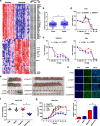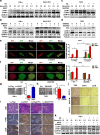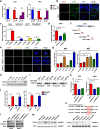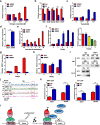Ai-lncRNA EGOT enhancing autophagy sensitizes paclitaxel cytotoxicity via upregulation of ITPR1 expression by RNA-RNA and RNA-protein interactions in human cancer
- PMID: 30999914
- PMCID: PMC6471868
- DOI: 10.1186/s12943-019-1017-z
Ai-lncRNA EGOT enhancing autophagy sensitizes paclitaxel cytotoxicity via upregulation of ITPR1 expression by RNA-RNA and RNA-protein interactions in human cancer
Abstract
Background: The biology function of antisense intronic long noncoding RNA (Ai-lncRNA) is still unknown. Meanwhile, cancer patients with paclitaxel resistance have limited therapeutic options in the clinic. However, the potential involvement of Ai-lncRNA in paclitaxel sensitivity remains unclear in human cancer.
Methods: Whole transcriptome sequencing of 33 breast specimens was performed to identify Ai-lncRNA EGOT. Next, the role of EGOT in regulation of paclitaxel sensitivity was investigated. Moreover, the mechanism of EGOT enhancing autophagy sensitizes paclitaxel cytotoxicity via upregulation of ITPR1 expression by RNA-RNA and RNA-protein interactions was investigated in detail. Furthermore, upstream transcriptional regulation of EGOT expression was also investigated by co-immunoprecipitation and chromatin immunoprecipitation. Finally, clinical breast specimens in our cohort, TCGA and ICGC were applied to validate the role of EGOT in enhancing of paclitaxel sensitivity.
Results: EGOT enhances autophagosome accumulation via the up-regulation of ITPR1 expression, thereby sensitizing cells to paclitaxel toxicity. Mechanistically, on one hand, EGOT upregulates ITPR1 levels via formation of a pre-ITPR1/EGOT dsRNA that induces pre-ITPR1 accumulation to increase ITPR1 protein expression in cis. On the other hand, EGOT recruits hnRNPH1 to enhance the alternative splicing of pre-ITPR1 in trans via two binding motifs in EGOT segment 2 (324-645 nucleotides) in exon 1. Moreover, EGOT is transcriptionally regulated by stress conditions. Finally, EGOT expression enhances paclitaxel sensitivity via assessment of cancer specimens.
Conclusions: These findings broaden comprehensive understanding of the biology function of Ai-lncRNAs. Proper regulation of EGOT may be a novel synergistic strategy for enhancing paclitaxel sensitivity in cancer therapy.
Keywords: Ai-lncRNA; Autophagy; Cancer; EGOT; ITPR1; Paclitaxel.
Conflict of interest statement
Ethics approval and consent to participate
All patients consented to an institutional review board-approved protocol that allows comprehensive analysis of tumor samples (Ethics committee of Harbin Medical University). This study conforms to the Declaration of Helsinki.
Consent for publication
Written informed consent for publication was obtained from the patients. All authors have agreed to publish this manuscript.
Competing interests
The authors declare that they have no competing interests.
Publisher’s Note
Springer Nature remains neutral with regard to jurisdictional claims in published maps and institutional affiliations.
Figures






Similar articles
-
The LncRNA RMST-miR-4295-ITPR1 axis: a key mechanism in regulating autophagy in triple-negative breast cancer cells.BMC Cancer. 2025 Apr 26;25(1):782. doi: 10.1186/s12885-025-14189-7. BMC Cancer. 2025. PMID: 40287640 Free PMC article.
-
Long non-coding RNA GBCDRlnc1 induces chemoresistance of gallbladder cancer cells by activating autophagy.Mol Cancer. 2019 Apr 5;18(1):82. doi: 10.1186/s12943-019-1016-0. Mol Cancer. 2019. PMID: 30953511 Free PMC article.
-
Long non-coding RNA FTH1P3 activates paclitaxel resistance in breast cancer through miR-206/ABCB1.J Cell Mol Med. 2018 Sep;22(9):4068-4075. doi: 10.1111/jcmm.13679. Epub 2018 Jul 3. J Cell Mol Med. 2018. PMID: 29971911 Free PMC article.
-
LncRNAs in modulating cancer cell resistance to paclitaxel (PTX) therapy.Med Oncol. 2024 Dec 13;42(1):28. doi: 10.1007/s12032-024-02577-1. Med Oncol. 2024. PMID: 39671022 Review.
-
Crucial Roles of LncRNAs-Mediated Autophagy in Breast Cancer.Int J Med Sci. 2022 Jun 21;19(6):1082-1092. doi: 10.7150/ijms.72621. eCollection 2022. Int J Med Sci. 2022. PMID: 35813295 Free PMC article. Review.
Cited by
-
H1Innovative approaches to combat anti-cancer drug resistance: Targeting lncRNA and autophagy.Clin Transl Med. 2023 Oct;13(10):e1445. doi: 10.1002/ctm2.1445. Clin Transl Med. 2023. PMID: 37837401 Free PMC article. Review.
-
The multiple functions and mechanisms of long non-coding RNAs in regulating breast cancer progression.Front Pharmacol. 2025 Mar 28;16:1559408. doi: 10.3389/fphar.2025.1559408. eCollection 2025. Front Pharmacol. 2025. PMID: 40223929 Free PMC article. Review.
-
The LncRNA RMST-miR-4295-ITPR1 axis: a key mechanism in regulating autophagy in triple-negative breast cancer cells.BMC Cancer. 2025 Apr 26;25(1):782. doi: 10.1186/s12885-025-14189-7. BMC Cancer. 2025. PMID: 40287640 Free PMC article.
-
Downregulation of LncRNA DARS-AS1 Inhibits the Tumorigenesis of Cervical Cancer via Inhibition of IGF2BP3.Onco Targets Ther. 2021 Feb 25;14:1331-1340. doi: 10.2147/OTT.S274623. eCollection 2021. Onco Targets Ther. 2021. PMID: 33658798 Free PMC article.
-
Identification of oxytocin-related lncRNAs and assessment of their expression in breast cancer.Sci Rep. 2021 Mar 19;11(1):6471. doi: 10.1038/s41598-021-86097-2. Sci Rep. 2021. PMID: 33742056 Free PMC article.
References
-
- Yu Y, Gaillard S, Phillip JM, Huang TC, Pinto SM, Tessarollo NG, Zhang Z, Pandey A, Wirtz D, Ayhan A, et al. Inhibition of spleen tyrosine kinase potentiates paclitaxel-induced cytotoxicity in ovarian Cancer cells by stabilizing microtubules. Cancer Cell. 2015;28:82–96. doi: 10.1016/j.ccell.2015.05.009. - DOI - PMC - PubMed
-
- Jeon YJ, Khelifa S, Ratnikov B, Scott DA, Feng Y, Parisi F, Ruller C, Lau E, Kim H, Brill LM, et al. Regulation of glutamine carrier proteins by RNF5 determines breast cancer response to ER stress-inducing chemotherapies. Cancer Cell. 2015;27:354–369. doi: 10.1016/j.ccell.2015.02.006. - DOI - PMC - PubMed
-
- Domenech E, Maestre C, Esteban-Martinez L, Partida D, Pascual R, Fernandez-Miranda G, Seco E, Campos-Olivas R, Perez M, Megias D, et al. AMPK and PFKFB3 mediate glycolysis and survival in response to mitophagy during mitotic arrest. Nat Cell Biol. 2015;17:1304–1316. doi: 10.1038/ncb3231. - DOI - PubMed
Publication types
MeSH terms
Substances
LinkOut - more resources
Full Text Sources
Medical
Molecular Biology Databases

